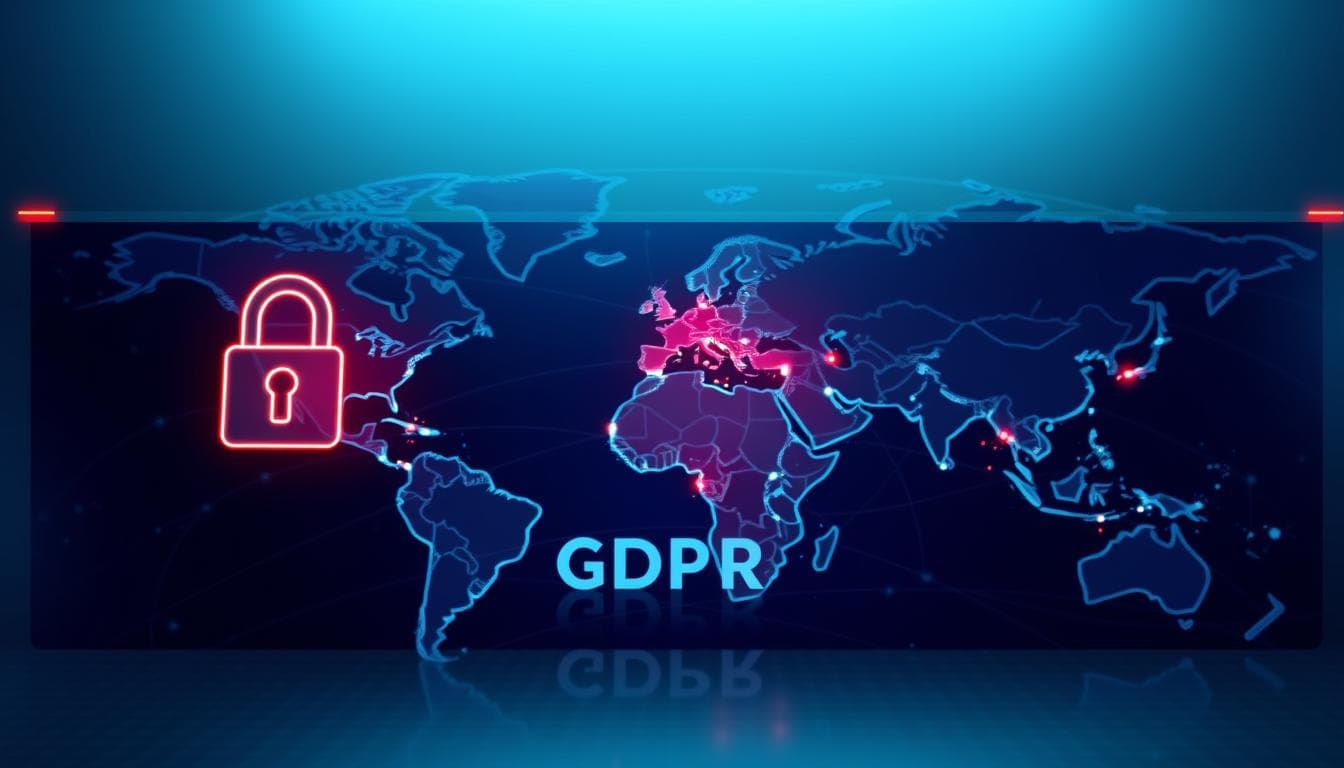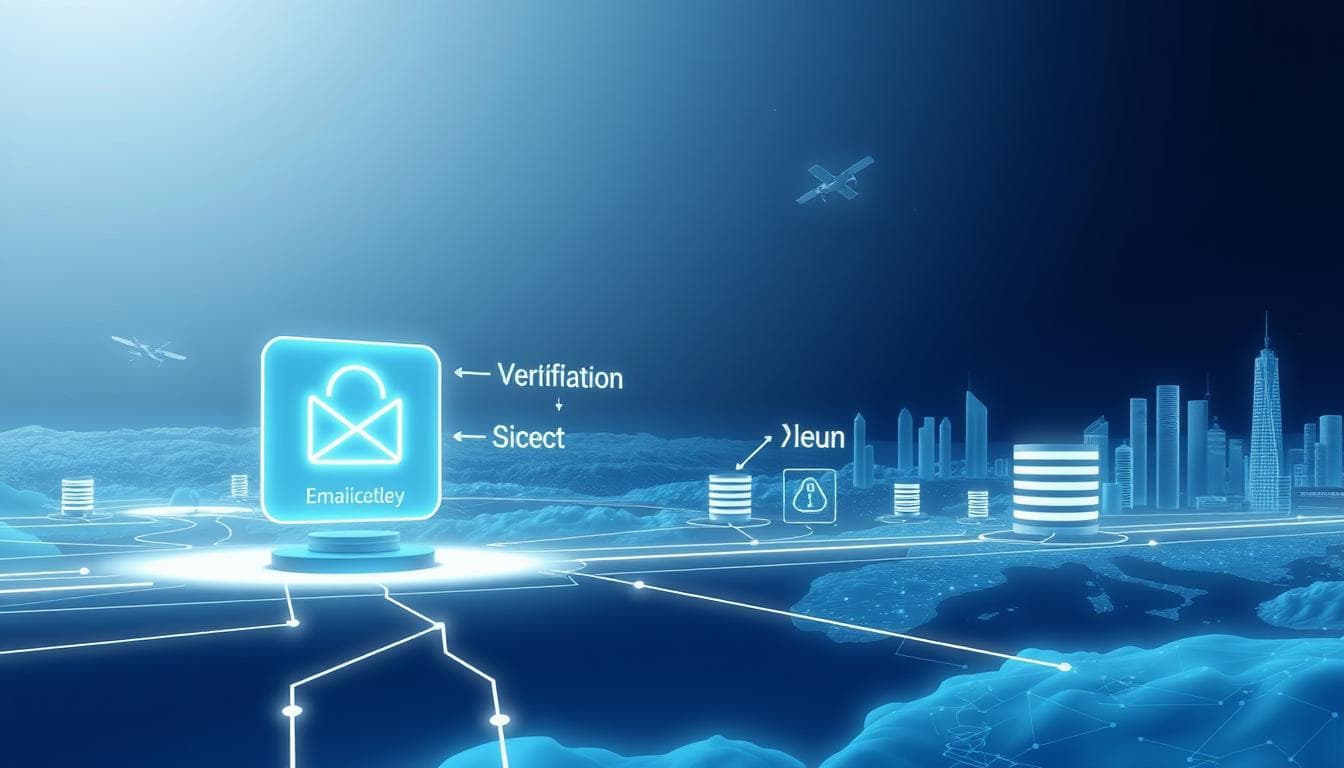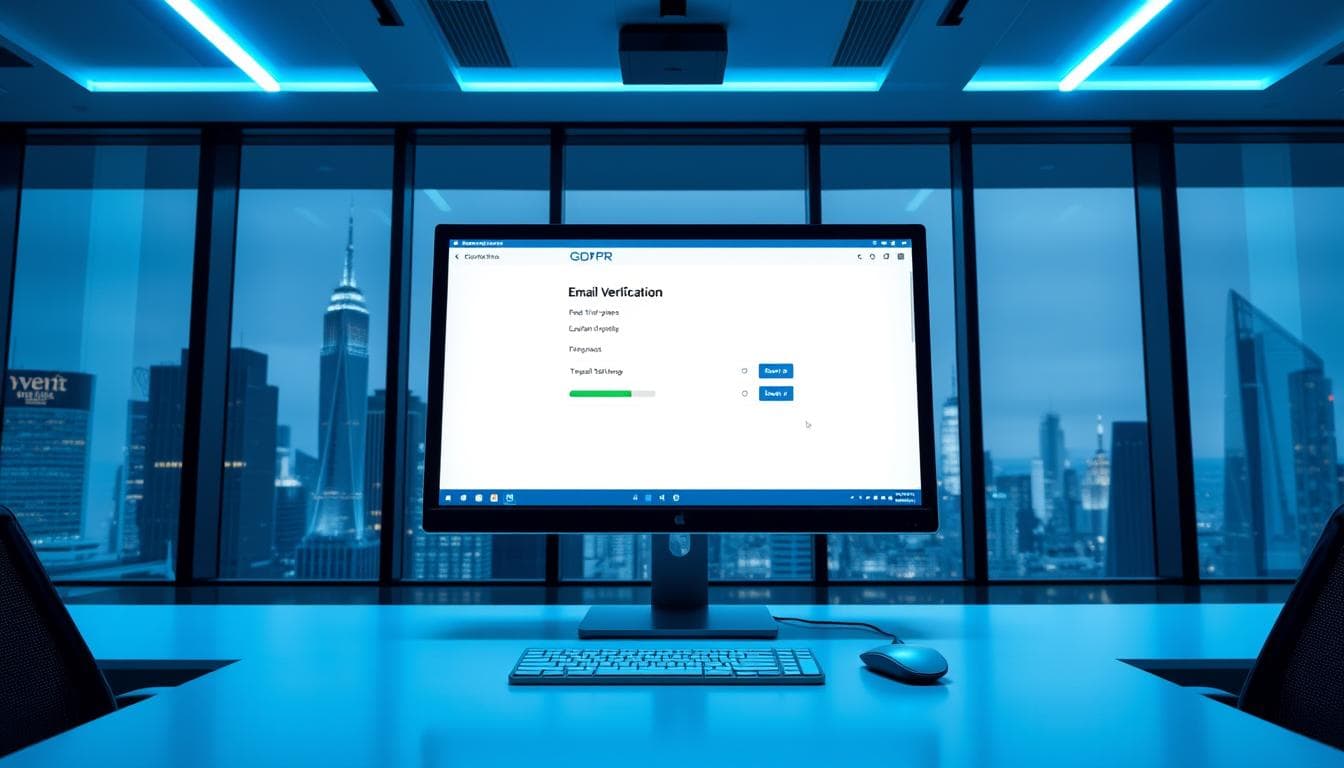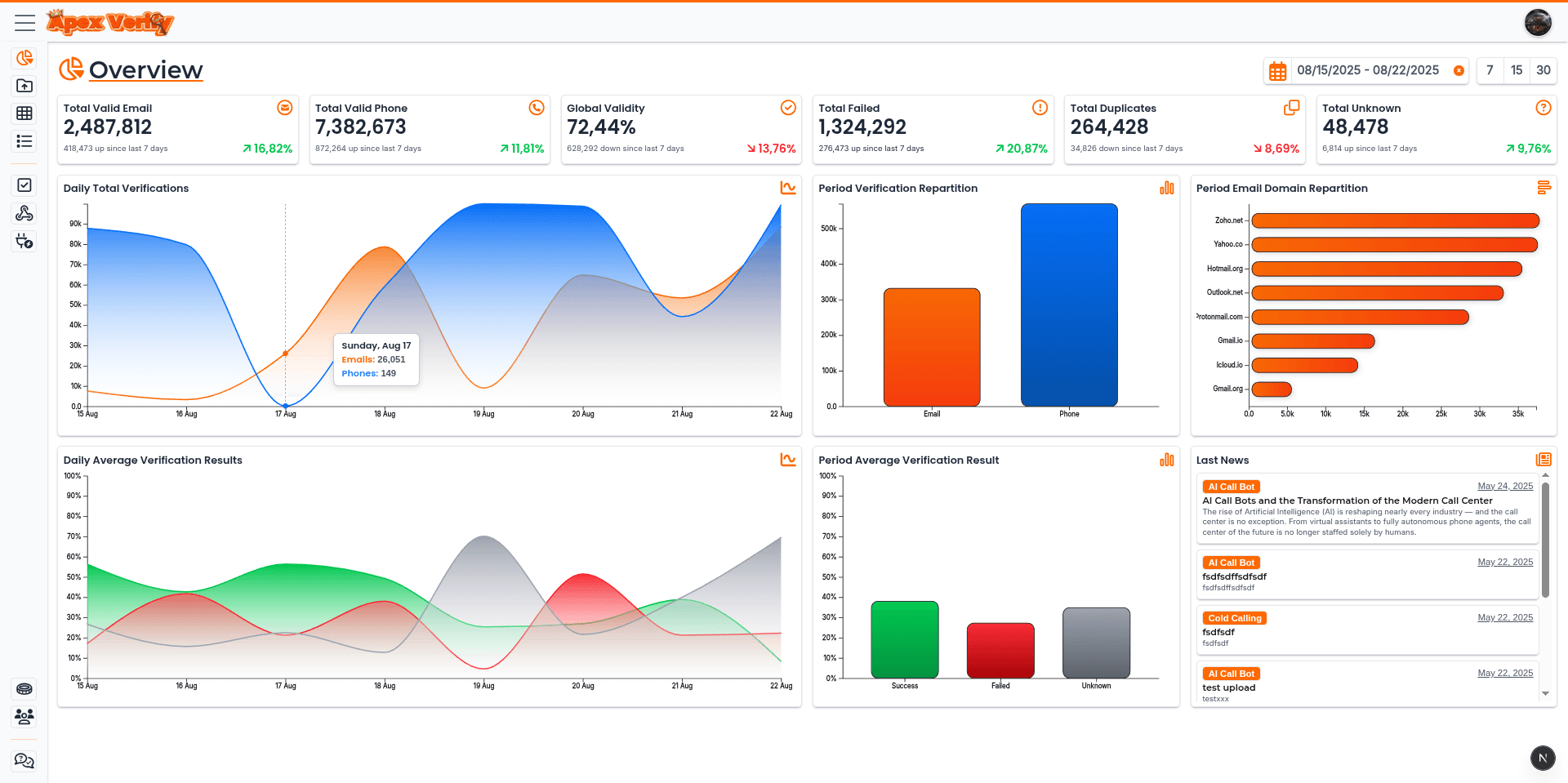In today's digital world, we face a critical challenge. Managing email verification processes while respecting privacy regulations is essential for every organization. As businesses expand their reach through digital communications, understanding the relationship between data privacy laws and contact list management is no longer optional.
The stakes are remarkably high. Organizations can face penalties reaching €20 million or 4% of global annual turnover under GDPR compliance requirements. Similar frameworks like the California Consumer Privacy Act reinforce these principles across jurisdictions. These regulations treat contact information as personal data, requiring proper consent and robust data protection measures.
We believe that proactive compliance creates genuine competitive advantages. Privacy-conscious consumers increasingly choose businesses that demonstrate transparent data handling practices. This guide explores how to build verification systems that protect privacy rights while maintaining list quality. We'll examine practical strategies, technical implementation approaches, and long-term maintenance of compliant processes that benefit both your organization and your audience.

Key Takeaways
- Contact information qualifies as personal data under privacy regulations, requiring businesses to obtain explicit consent before processing or storing addresses
- Non-compliance can result in substantial financial penalties up to €20 million or 4% of annual global turnover under current frameworks
- Organizations must implement proper opt-out mechanisms and demonstrate how consent was obtained for all contact records
- Privacy-compliant verification processes build consumer trust and create competitive advantages in privacy-conscious markets
- Businesses operating across jurisdictions must navigate multiple regulatory frameworks including European and California standards
- Effective verification systems balance list quality maintenance with individual privacy rights protection
Understanding Privacy Regulations: GDPR and CCPA Fundamentals
Every business collecting email addresses operates within a complex framework of data privacy laws. These laws extend far beyond their physical location. They establish strict standards for processing, storing, and protecting personal information, including email data. Understanding these privacy frameworks is essential for maintaining compliant email verification practices.
We must navigate multiple regulatory environments simultaneously. Privacy legislation varies by jurisdiction while sharing common principles. The General Data Protection Regulation and the California Consumer Privacy Act are two influential frameworks affecting email operations. Both treat email addresses as protected personal data requiring careful handling.
The European Union's Comprehensiv Privacy Framework
The General Data Protection Regulation represents the European Union's overarching legislation on data privacy. It unifies baseline requirements among 27 member nations. This framework took effect in May 2018, establishing unprecedented standards that have influenced privacy regulation worldwide. The GDPR applies to businesses that collect and use data on any EU-based user, regardless of where the business is headquartered.
At its core, GDPR establishes eight fundamental principles that govern all data processing activities. These principles include lawfulness, fairness, and transparency in how we collect data. They also mandate purpose limitation, ensuring we only use data for specified reasons.
The regulation requires data minimization, meaning we collect only what's necessary for our stated purposes. Accuracy, storage limitation, integrity, confidentiality, and accountability complete the framework. Each principle directly impacts how we verify and manage email addresses.
The extraterritorial reach of this privacy regulation means geographic location provides no exemption. If we process data belonging to EU residents, we must comply with GDPR requirements. This includes email verification activities, list management, and engagement tracking.

Compliance Obligations for American Companies
US businesses must comply with GDPR in specific scenarios that many companies overlook. The most common misconception is that only companies with physical presence in Europe face obligations. In reality, the regulation's scope extends to any organization processing EU residents' personal data.
We trigger compliance requirements when targeting EU markets through our products or services. This includes maintaining email lists containing European subscribers. Monitoring EU individuals' behavior also creates obligations, such as tracking how European users interact with our emails.
Even incidental processing of EU residents' data requires compliance. If our email verification system processes addresses belonging to European users, we fall under GDPR jurisdiction. The regulation makes no exceptions based on company size, industry, or revenue.
- Offering goods or services to EU residents, even if free
- Monitoring behavior of individuals located in the EU
- Processing payment information from European customers
- Tracking website visitors from EU member states
California's Groundbreaking Privacy Legislation
The California Consumer Privacy Act emerged as America's first major privacy legislation, taking effect in January 2020. The CCPA was modeled largely after GDPR with some key differences reflecting California's consumer protection priorities. This data privacy law applies to businesses meeting specific thresholds: annual gross revenues exceeding $25 million, processing data on 50,000 or more consumers, or deriving 50% or more of revenue from selling consumer information.
Under the California Consumer Privacy Act, email addresses constitute personal information requiring protection. Users must consent to communication and be able to opt out at any time. The legislation goes further by classifying data regarding open rates and click-through rates as personal information.
Civil penalties for CCPA violations range from $2,500 per unintentional violation to $7,500 per intentional violation. Businesses generally have 30 days to reverse violations before penalties apply. This enforcement structure emphasizes correction over punishment, though repeated violations face escalating consequences.
The CCPA grants California residents specific rights over their personal data. These include the right to know what information we collect, the right to delete personal information, and the right to opt out of data sales. We must honor these requests within specified timeframes, typically 45 days.
Unified Compliance Across Multiple Jurisdictions
Both privacy regulations share substantial common ground, allowing us to implement unified compliance strategies. Both frameworks treat email addresses as personal data requiring explicit consent for collection and processing. They mandate transparency about data usage, giving individuals control over their information.
The right to access, correct, and delete personal data appears in both regulations. We must provide clear mechanisms for individuals to exercise these rights. Data security requirements also overlap significantly, requiring appropriate technical and organizational measures to protect email data.
Implementing a compliance approach that satisfies both GDPR and CCPA simultaneously reduces complexity. We establish consistent privacy standards across all operations. This unified strategy ensures that all users receive the same high level of data protection, regardless of their location.
The principles of data minimization and purpose limitation work identically under both frameworks. We collect only necessary email data and use it exclusively for stated purposes. Retention schedules must align with business needs while respecting individual rights to deletion.
By mapping these overlapping requirements, we create streamlined processes that satisfy multiple data privacy laws efficiently. This approach positions our business to adapt quickly as new privacy regulations emerge in other jurisdictions. Understanding these fundamental frameworks provides the foundation for compliant email verification practices that respect user privacy while supporting business objectives.
The Intersection of Email Verification and Data Privacy
When businesses validate email addresses, they navigate a complex legal landscape governed by data protection laws. Email verification is not just a technical process, it falls under strict regulatory oversight. This is because email addresses are considered personal data, triggering specific obligations under GDPR and similar privacy frameworks.
It's important to recognize that email verification cannot be separated from privacy compliance. These two concerns are deeply intertwined. Every validation check, deliverability test, and list cleaning operation involves processing personal data protected by privacy laws.

Technical Mechanisms Behind Email Validation
Email verification systems use multiple technical steps to assess address validity. Each step processes personal data, triggering regulatory requirements. Understanding these mechanisms helps businesses identify their compliance obligations.
The verification process starts with syntax validation, checking if an email address follows proper formatting rules. This initial check happens instantly and requires minimal data processing. Yet, even this simple step involves handling personal information subject to GDPR Article 5(1)(d), which mandates accuracy and up-to-dateness.
Domain verification follows, where systems check if the email domain exists and can receive messages. This step involves querying DNS records and mail server configurations. While technical, it also processes personal data by associating specific addresses with valid domains.
SMTP verification is the most intrusive validation method. Systems connect directly to recipient mail servers to confirm whether specific addresses can receive messages. This process transmits personal data across networks, creating logs on multiple systems. Each transmission point becomes a compliance touchpoint requiring security measures and documentation.
Deliverability testing goes beyond simple validation by assessing whether messages actually reach inboxes. Some verification services maintain historical data about bounce rates, spam complaints, and engagement metrics. This creates extensive personal data processing activities that require proper legal basis under privacy regulations.
Understanding Controller and Processor Responsibilities
The GDPR establishes a shared responsibility framework between data controllers and data processors. Businesses maintaining email lists function as data controllers, they determine why and how personal data gets processed. Email verification companies operate as data processors, handling information on behalf of controllers.
Personal data shall be adequate, relevant and limited to what is necessary in relation to the purposes for which they are processed.
GDPR Article 5(1)(c) - Data Minimization Principle
This distinction carries significant implications. Controllers cannot simply transfer liability to their verification vendors. Both parties bear legal obligations for data protection. When verification services experience data breaches or privacy violations, both the service provider and their business clients face possible liability.
We see this shared responsibility play out in enforcement actions. Regulators investigate both parties when privacy violations occur during email verification. The company that hired the verification service cannot claim ignorance of how their processor handled personal data.
Privacy Violations That Commonly Occur
Many businesses inadvertently violate privacy regulations through email verification practices they consider routine. These violations often stem from misunderstanding regulatory requirements, not intentional misconduct. Recognizing these violations helps prevent costly mistakes.
Excessive data collection represents the most frequent violation. Some verification services request or collect information beyond what validation requires. Under data minimization principles, businesses should only process data necessary for their specific purpose. Collecting birthdates, phone numbers, or demographic information alongside email verification violates this principle.
Security failures during data transmission create another common violation. Personal data moving between systems requires encryption and protection. When verification services transmit email addresses over unsecured connections, they breach fundamental data protection requirements. This becomes problematic during bulk verification operations involving thousands of addresses.
- Retaining verified addresses longer than necessary for the validation purpose
- Sharing email lists with unauthorized third parties or affiliate networks
- Processing data without establishing proper legal basis under GDPR Article 6
- Failing to obtain valid consent before verification in consumer-facing contexts
- Inadequate vendor oversight allowing processors to violate privacy commitments
List purchasing presents particular compliance risks. When businesses buy email lists, they often cannot demonstrate lawful basis for processing those addresses. The individuals never consented to share their information with the purchasing company. Verifying purchased lists compounds the violation by adding another layer of unauthorized personal data processing.
Third-party sharing without consent violates transparency requirements. Some verification providers share or sell verified email lists to other businesses. This practice typically occurs without the knowledge or permission of the data subjects. It represents a fundamental breach of privacy regulations.
Financial and Operational Consequences
Non-compliance with data protection regulations during email verification carries consequences that extend far beyond monetary penalties. The costs affect multiple dimensions of business operations and can threaten company viability.
GDPR penalties reach up to €20 million or 4% of annual global turnover, whichever proves higher. These maximum fines apply to serious violations involving large-scale personal data processing. Email verification operations affecting thousands of individuals can easily trigger substantial penalties. Enforcement authorities consider the number of affected individuals when calculating fines.
Reputational damage often exceeds direct financial penalties. When businesses experience privacy violations related to emailing practices, news spreads quickly through professional networks and media coverage. Customer trust erodes rapidly once privacy failures become public. Rebuilding reputation requires years of consistent compliance demonstration.
Operational disruptions from regulatory investigations consume significant resources. Companies must dedicate staff time to responding to information requests, producing documentation, and implementing corrective measures. These investigations can last months or years, creating sustained operational burdens.
- Legal defense costs accumulate quickly during privacy violation proceedings
- Mandatory security improvements require immediate investment in technical infrastructure
- Customer compensation may be required when personal data breaches cause harm
- Business restrictions can limit processing activities until compliance is demonstrated
- Insurance premium increases follow privacy incidents and enforcement actions
Recent enforcement actions demonstrate these risks clearly. Multiple companies have faced penalties exceeding €1 million for email-related privacy violations. These cases involved unauthorized personal data processing, inadequate security measures, and failures to honor individual rights requests. The violations affected thousands of individuals simultaneously, amplifying the regulatory response.
We must emphasize that compliance costs far less than remediation after violations occur. Proactive privacy measures during email verification protect businesses from existential risks. The intersection of email verification and data privacy demands careful attention from every organization engaged in digital marketing and customer communication.
GDPR Compliance And Email Verification: What Every Business Should Know
Every business verifying email addresses must have a clear legal reason for processing personal data. The GDPR doesn't allow for collecting and verifying emails without proper authorization. It's essential to understand the specific frameworks that make our verification activities lawful under GDPR compliance standards.
This section explores the foundational requirements for compliant email verification practices. We'll look at how to build systems that respect individual privacy while maintaining effective verification processes.
Establishing Legal Basis for Email Verification
GDPR permits data processing under six specific lawful grounds. For email verification, three primary options emerge as most relevant: consent, legitimate interest, and contractual necessity. Choosing the appropriate legal basis shapes every aspect of your verification system.
The legal basis you select determines what information you can collect and how long you can retain it. Each option comes with distinct requirements and obligations that affect your operational procedures.
Consent Requirements and Documentation
Valid consent under GDPR requires meeting four essential criteria: freely given, specific, informed, and unambiguous. These aren't just legal buzzwords, they translate into concrete practices that protect both your business and your users.
Pre-checked boxes violate consent requirements. Subscribers must actively check boxes themselves for permission to be valid. This means your signup forms need clear, affirmative action from users.
We recommend implementing double opt-in processes for stronger consent management. Here's how this works:
- User submits their email address through your form
- System sends a confirmation email explaining what content they'll receive
- User clicks a verification link to confirm their subscription
- System records the confirmation with timestamp and method
Documentation requirements extend beyond simply recording "yes" or "no" responses. Your records must capture who consented, when they consented, how they consented, and what information they received about data use. This creates an audit trail demonstrating your compliance efforts.
Consent records should include the exact language of your consent request, the date and time of acceptance, and the IP address or device identifier. These details prove you obtained permission properly if questions arise later.
Legitimate Interest Assessments
Legitimate interest provides an alternative legal basis when consent isn't practical or appropriate. This option requires conducting a formal Legitimate Interest Assessment (LIA) that balances your business needs against individual privacy rights.
Your LIA should document three key elements:
- The specific business purpose driving your email verification needs
- The necessity of verification for achieving that purpose
- The impact on individuals and safeguards you've implemented
Legitimate interest works well for fraud prevention and security purposes. If you're verifying emails to prevent account takeovers or bot registrations, you can likely demonstrate this legal basis effectively.
Legitimate interest doesn't override individual rights. People can object to processing based on legitimate interest, and you must honor those objections unless you demonstrate compelling grounds that override their interests.
Contractual Necessity Considerations
Contractual necessity applies when email verification is essential for fulfilling agreements with customers. This legal basis fits situations where you cannot deliver services without validating email addresses.
Account creation typically qualifies under contractual necessity. If users need functioning email addresses to receive order confirmations, password resets, or account notifications, verification becomes part of the contract performance.
The key test is whether you could reasonably provide the service without email verification. If the answer is no, contractual necessity provides solid legal basis. If verification simply improves your operations but isn't strictly necessary, you'll need a different justification.

Data Minimization Principles in Practice
Data minimization means collecting only what you genuinely need for your stated purpose. This principle challenges businesses to resist the temptation of gathering additional information simply because it's available.
For email verification, minimization requires asking yourself: What data is absolutely necessary to confirm this email address works? In most cases, that's just the email address itself and perhaps a timestamp.
Avoid these common minimization violations:
- Requiring phone numbers when verifying emails
- Collecting physical addresses during email validation
- Storing IP addresses longer than necessary for fraud prevention
- Recording browser fingerprints without clear security justification
We've seen companies gather extensive demographic data during signup, claiming it's part of "verification." Unless you can demonstrate specific necessity, this violates GDPR compliance standards. Keep your verification focused and purposeful.
Regular audits help maintain minimization standards. Review your verification forms quarterly to ensure you haven't gradually added unnecessary fields over time.
Transparency and Individual Rights
Your privacy policy must clearly explain how email verification works within your systems. Users deserve straightforward information about what happens to their data during and after verification.
Transparency requires using plain language that average readers understand. Avoid legal jargon and technical terminology that obscures meaning. Your privacy policy should answer these questions directly:
- Why are we verifying your email address?
- What data do we collect during verification?
- How long do we keep verification records?
- Who has access to your email data?
- What rights do you have regarding this information?
Place verification explanations where users naturally look for them, near signup forms and in confirmation emails. Don't bury critical information in dense policy documents that nobody reads.
Right to Access and Data Portability
Data subject rights include the ability to request access to personal information you've collected. When someone exercises this right, you have one month to respond with a complete copy of their data.
For email verification systems, access requests should include:
- The email address and any associated metadata
- Verification timestamps and methods used
- Consent records and legal basis documentation
- Any communication preferences or opt-out records
Data portability extends beyond simple access. Users can request their information in structured, commonly used formats that allow transfer to other services. CSV or JSON formats typically satisfy this requirement for email data.
We recommend building automated systems that generate access reports. Manual compilation becomes impractical as your subscriber base grows and risks human error that could expose other users' data.
Right to Erasure in Email Systems
GDPR grants EU citizens the right to be forgotten. When someone requests deletion, you must remove their personal data unless you have compelling legal grounds to retain it.
Email platforms should include unsubscribe links in every template. These links give users immediate control over their subscription status without requiring complex request procedures.
Provide access to subscriber profiles where people can manage their preferences. Self-service options reduce your administrative burden while empowering users to exercise data subject rights independently.
When users unsubscribe, add them to suppression lists instead of deleting their records. This prevents accidental re-contact and demonstrates your commitment to respecting their choices. Suppression lists contain minimal information, typically just the email address and opt-out date.
Erasure requests require broader action than simple unsubscribes. You must remove the data from active databases, backups, and any third-party processors you work with. Document your deletion process to prove compliance if regulators inquire later.
Balance erasure obligations against legitimate retention needs. Financial records, fraud prevention data, and legal compliance documentation may justify keeping some information despite deletion requests. Your privacy policy should explain these exceptions clearly before users submit their data.
Proven Strategies for GDPR-Compliant Email Verification
Privacy-first email verification strategies empower businesses to maintain data quality while respecting regulatory boundaries. Understanding the rules is just the beginning. It demands practical implementation of technical methods that validate addresses without creating unnecessary privacy risks.
Our strategies focus on minimizing data retention and maximizing transparency. This allows organizations to verify email authenticity while keeping personal information secure throughout the process.
Real-Time SMTP Verification Methods
Real-time verification is the gold standard for privacy-compliant email validation. Unlike batch processing, real-time verification checks addresses at the moment of collection. This approach significantly reduces data retention requirements and associated privacy risks.
We recommend implementing SMTP-based validation that operates through immediate server communication. This method verifies deliverability without creating permanent records of personal data.
Syntax and Format Validation
The first layer of privacy-preserving validation checks whether email addresses follow standard formatting rules. This process occurs entirely within your own systems without transmitting data externally.
Syntax validation confirms that addresses contain the required components: a local part, the @ symbol, and a domain portion. It identifies obvious errors like missing characters or invalid formatting patterns. Because this validation happens locally, no personal information leaves your infrastructure.
Format checks also verify that addresses don't contain prohibited characters or exceed length limits. These automated checks catch data entry mistakes immediately while maintaining complete privacy control.
Domain and MX Record Checks
Domain verification validates that the email address belongs to a functioning mail server. This process queries public DNS records to confirm the domain exists and can receive messages.
MX record checks examine mail exchange records that direct email traffic to the correct servers. We perform these checks by querying publicly available DNS infrastructure. This means no personal email addresses are exposed to third parties during validation.
The verification confirms deliverability at the domain level without requiring mailbox-specific information. This approach balances accuracy with privacy protection effectively.
Advanced smtp verification techniques can confirm that specific mailboxes exist without retaining personal data. These methods communicate with recipient mail servers to verify deliverability in real time.
The process works by initiating an SMTP conversation with the destination server. Your verification system connects to the mail server and simulates the beginning of a message delivery. The recipient server responds with status codes indicating whether the mailbox exists and can receive mail.
Critically, this verification occurs without completing the email transmission or storing address information. Implementing immediate data purging after validation ensures zero data retention. The entire verification cycle completes in milliseconds, providing instant feedback while maintaining privacy standards.

Privacy-Preserving Email Validation Techniques
Beyond traditional SMTP methods, several cutting-edge approaches minimize privacy exposure even further. We encourage businesses to explore these advanced techniques as part of a complete compliance strategy.
On-premises verification solutions keep all data processing within your own infrastructure. These systems validate addresses without ever transmitting information to external services. Organizations with strict data sovereignty requirements will find this approach beneficial.
API-based real-time verification with immediate response and zero storage offers another privacy-focused option. These services process validation requests instantly and return results without creating logs or databases of verified addresses.
Hash-based verification methods provide an additional privacy layer. These techniques transform email addresses into anonymous hash values before processing. Even if a breach occurred, the hashed data cannot be reverse-engineered to reveal actual email addresses.
Privacy-by-design architectures embed data protection directly into technical systems. Instead of adding privacy controls as an afterthought, these frameworks build protection into every verification component from the ground up.
Choosing Compliant Email Verification Providers
Selecting the right email verification vendor directly impacts your compliance posture. Email verification companies must comply with GDPR and share responsibility for data security alongside your organization.
We recommend conducting thorough due diligence before engaging any verification service. This process protects your business from compliance risks that third-party processors might introduce.
Start by reviewing provider privacy policies and data protection documentation. These materials should be publicly accessible and written in clear language. Look for explicit commitments to GDPR, CCPA, and other relevant privacy regulations.
Verify whether the provider employs a Data Protection Officer and maintains accessible contact channels. This indicates organizational commitment to privacy governance. Determine where the company is based and where servers are hosted, prioritizing jurisdictions with adequate data protection frameworks.
Examine security measures against intrusion and data breaches. Reputable providers implement multiple protection layers including:
- Physical controls restricting server access to authorized personnel
- Network security protocols preventing unauthorized connections
- Strong authentication requirements for administrative access
- Comprehensive incident response plans for breach scenarios
- Regular security patches and system updates
Investigate data retention periods and deletion protocols. Vendor compliance depends heavily on how long providers keep verification data and how thoroughly they eliminate it afterward.
Data Processing Agreements Requirements
A robust data processing agreement forms the legal foundation of your relationship with verification vendors. GDPR Article 28 mandates specific DPA elements that protect both parties and the individuals whose data is processed.
Your data processing agreement must clearly define the scope, duration, and purpose of all processing activities. It should specify exactly what types of data the vendor will handle and under what circumstances.
Essential DPA components include:
- Processing scope defining what verification activities the vendor performs
- Data types specification listing all personal information categories involved
- Security obligations detailing technical and organizational measures
- Sub-processor management outlining approval processes for vendors using additional service providers
- Breach notification procedures establishing timelines and communication protocols
The agreement should grant you audit rights to verify vendor compliance at reasonable intervals. This provision enables ongoing monitoring of third-party security practices. Include provisions for data return or deletion when the verification relationship ends.
Negotiate terms that require vendors to assist with data subject requests. When individuals exercise rights to access or delete their information, your verification provider must support these requests promptly.
Vendor Security and Certification Standards
Industry certifications provide objective validation of vendor security practices. We advise prioritizing providers with recognized compliance credentials that demonstrate commitment to data protection.
ISO 27001 certification indicates a vendor has implemented a thorough information security management system. This international standard covers risk assessment, security controls, and continuous improvement processes.
SOC 2 Type II reports verify that service providers maintain appropriate controls over security, availability, and confidentiality. Unlike Type I reports that assess controls at a single point in time, Type II examinations evaluate effectiveness over an extended period.
Look for vendors with specific privacy certifications like Privacy Shield (for historical context) or Standard Contractual Clauses for international transfers. These mechanisms ensure lawful data movement across borders.
Confirm that providers conduct regular penetration testing and vulnerability assessments. External security audits identify weaknesses before malicious actors can exploit them. Providers should readily share summary findings from these evaluations.
Evaluate incident response capabilities and breach notification procedures. Even with strong preventive measures, security incidents can occur. The vendor's ability to detect, contain, and communicate about breaches affects your own compliance obligations.
Request information about data encryption practices both in transit and at rest. Modern encryption standards protect email verification data from unauthorized access throughout processing workflows. Vendors using outdated encryption methods or inadequate key management introduce unnecessary risks.
Implementing Technical and Administrative Safeguards
To ensure GDPR-compliant email verification, robust safeguards are essential across all layers. Technical infrastructure and administrative procedures must protect personal data during verification. This combination satisfies regulatory needs and builds trust with subscribers.
Compliance hinges on transparency, security, and accountability. Each aspect demands careful planning and consistent execution within your organization.
Updating Your Privacy Policy for Email Verification
Your privacy policy must clearly outline all email verification activities. Place this information prominently on your website. It should explain the verification process, its necessity, and legal basis.
Include your organization's details and Data Protection Officer's contact information. Specify the personal data collected and retention periods for verified email addresses. Also, detail any third-party processors involved in verification.
Transparency is key in disclosing international data transfers. If data is stored outside the European Economic Area, explain the safeguards protecting it. Use clear language to avoid legal jargon.
Your policy must outline subscriber rights fully. These include access requests, correction demands, deletion rights, and objection options. Provide specific instructions for exercising these rights, including contact information and expected response times.
Building Compliant Consent Mechanisms
Effective consent mechanisms are the cornerstone of GDPR compliance for email verification. Design systems that capture clear, granular permission for specific processing activities. Bundled consent does not meet regulatory standards.
Your consent interface should present each purpose separately with individual checkboxes. Avoid pre-ticked boxes as they do not demonstrate active agreement. Explain the purpose and benefits of providing information clearly.
Keep detailed consent records documenting date, time, method, and specific permissions granted. These records prove compliance during audits and help resolve disputes.
Double Opt-In Best Practices
Double opt-in processes provide strong evidence of intentional consent while validating email deliverability. Send a confirmation message immediately after someone submits their email address. This requires explicit action to finalize the subscription.
The confirmation email should clearly identify your organization and explain what the recipient is confirming. Include a prominent verification button or link to complete the subscription process. This creates documented proof of active consent.
Your system must not send marketing messages before receiving confirmation. Only transactional emails related to completing the opt-in process are permissible during this stage. Store timestamp data showing when initial submission occurred and when confirmation was completed.
Preference Centers and Unsubscribe Options
Preference centers empower subscribers to manage their consent mechanisms granularly. Build interfaces where individuals can select specific communication types, adjust frequency preferences, and choose topic categories. These controls demonstrate respect for subscriber autonomy and reduce complaint rates.
Every emailing message must include a visible unsubscribe link that requires minimal effort to use. One-click unsubscribe functionality represents the gold standard, eliminating barriers to exercising withdrawal rights. Your system should process unsubscribe requests immediately, within 24 hours or 10 business days as regulations require.
Confirmation messaging reassures unsubscribed individuals that their request was successful. Add unsubscribed addresses to suppression lists to prevent accidental recontact across all emailing systems and campaigns.
Data Security Measures for Email Verification
GDPR requires organizations to implement appropriate technical measures protecting personal data from unauthorized access, loss, or destruction. Data security standards must address both data in transit and data at rest throughout the verification lifecycle.
Physical security controls limit who can access servers storing email addresses. Network security protections prevent external intrusions. Implement strong password requirements across all systems handling personal data, with multi-factor authentication for administrative access.
Your organization needs documented incident response plans detailing steps to take when security breaches occur. Regular security patches, virus scanning, and malware protection updates defend against evolving threats. Continuous monitoring systems detect suspicious activity before significant damage occurs.
Encryption Standards for Data in Transit
Transport Layer Security (TLS) version 1.2 or higher should protect all data transmission between systems during email verification processes. This encryption prevents interception of email addresses and related personal data as information moves across networks.
When verification APIs communicate with your systems, encryption must secure those connections. Third-party verification providers should demonstrate their encryption standards through documentation or certifications. Avoid providers that cannot guarantee current encryption protocols.
Email communications containing verification links must also use secure transmission protocols. Your email infrastructure should enforce TLS for outbound messages whenever recipient servers support it.
Secure Storage and Access Controls
Advanced Encryption Standard (AES) with 256-bit keys represents the recommended minimum for encrypting stored email addresses and associated verification data. Database fields containing personal information should use field-level encryption providing additional protection even if broader database security fails.
Role-based access controls limit who can view or modify email verification data. Implement the principle of least privilege, granting employees only the access necessary for their specific job functions. Regular access reviews identify and remove unnecessary permissions as roles change.
Audit logging captures every instance of data security access, creating accountability trails. These logs should record who accessed which records, when access occurred, and what actions were performed. Retain audit logs separately from operational systems to prevent tampering.
Retention Schedules and Data Deletion Protocols
Data retention policies must balance legitimate business needs against privacy principles favoring minimal data storage. Determine the shortest period necessary for each processing purpose, then establish clear deletion schedules aligned with those timeframes.
Verified email addresses used solely for list cleaning might require retention only until verification status is confirmed. Subscriber data for ongoing emailing campaigns justifies longer retention while active consent continues. Inactive or unengaged subscribers present retention risks requiring evaluation of continued storage necessity.
Your privacy policy should specify retention periods transparently. Automated deletion systems execute scheduled purges without requiring manual intervention. Implement multiple review stages before permanent deletion to prevent accidental removal of data serving legitimate purposes.
Deletion protocols must address all storage locations including backup systems, archived databases, and third-party processors. Documentation proving data disposal becomes important during privacy audits verifying compliance with data retention commitments.
Regular reviews of retention schedules ensure policies remain aligned with evolving business practices and regulatory requirements. We recommend annual assessments questioning whether existing retention periods serve necessary purposes or whether shorter timeframes would suffice.
Maintaining Long-Term Compliance in Email Operations
Effective data protection programs integrate compliance into daily operations, not just as isolated events. Recognizing that GDPR compliance and other privacy regulation frameworks demand ongoing attention is key. Cultivating a privacy-focused culture within your organization ensures email verification processes stay compliant as your business grows and regulations evolve.
Organizations that treat compliance as an ongoing commitment achieve better results. They build resilience against regulatory changes and minimize the risk of costly violations. Establishing robust accountability frameworks is essential, designating specific individuals or teams with data protection responsibilities throughout your organization.
Conducting Regular Privacy Audits
Scheduled compliance audits are vital to verify email verification practices align with GDPR compliance requirements. Implementing a tiered audit approach is recommended. This includes quarterly assessments of email verification processes, annual privacy audits covering all data processing activities, and periodic vendor compliance reviews.
These systematic reviews examine various aspects of your operations. Technical audits assess security controls and identify vulnerabilities in your email verification systems. Documentation reviews ensure policies accurately reflect actual practices, not outdated procedures.
Developing audit checklists specific to email verification standardizes your review process. Your checklists should cover:
- Consent documentation completeness and validity
- Data minimization adherence in collection practices
- Retention policy compliance and deletion protocols
- Security measure effectiveness and incident logs
- Vendor agreement currency and performance metrics
Organizations should schedule periodic audits, focusing on high-risk vendors to verify GDPR compliance. These vendor assessments protect your business from liability when third-party processors fail to meet privacy standards. Quarterly vendor reviews provide sufficient oversight without creating excessive administrative burden.
Training Your Team on Privacy Regulations
Compliance failures often stem from lack of awareness, not malicious intent. We emphasize the importance of privacy regulation training for all personnel handling email data. Your training strategy should recognize that different roles require different levels of knowledge and practical applications.
Implementing role-specific training ensures each team member understands their responsibilities. Marketing teams need detailed guidance on consent mechanisms and data minimization. IT personnel require technical security training focused on encryption and access controls. Customer service representatives must understand data subject rights and proper response procedures.
Effective training programs extend beyond initial onboarding. We recommend establishing regular training schedules that include:
- Annual refresher courses covering GDPR compliance fundamentals
- Quarterly updates on new regulatory updates and enforcement trends
- Scenario-based exercises using realistic situations your team might encounter
- Assessments to measure comprehension and identify knowledge gaps
Creating accessible reference materials helps employees apply their training in daily operations. Quick-reference guides, decision trees for consent situations, and clear escalation procedures support consistent compliance across your organization. Integrating privacy considerations into existing workflows increases adherence more effectively than treating them as separate requirements.
Managing Cross-Border Email Verification
Email lists with international subscribers introduce significant complexity to your compliance obligations. If you transfer personal data from the EU to other countries, your business must follow specific GDPR compliance rules governing international data transfers. These requirements exist because privacy protections vary dramatically across jurisdictions.
Your first step involves identifying where your subscribers are located. This geographic mapping enables you to apply appropriate legal frameworks to each data processing activity. We recommend implementing systems that track subscriber locations and flag transfers requiring additional safeguards.
Businesses should check if destination countries appear on the EU's list of adequate countries for approved transfers. The European Commission maintains this list of jurisdictions that provide GDPR-equivalent protection. Transfers to adequate countries proceed without additional mechanisms because the destination already ensures appropriate privacy standards.
For transfers to countries without adequacy decisions, you must implement appropriate safeguards. Standard Contractual Clauses (SCCs) represent the most common mechanism for legitimizing international data transfers. These legally binding contracts between data exporters and importers guarantee GDPR-level protection regardless of local laws.
Alternative mechanisms include Binding Corporate Rules (BCRs) for multinational organizations. These internal policies establish consistent privacy standards across all corporate entities. BCRs require regulatory approval and substantial documentation, making them practical for large enterprises with complex international operations.
Conducting transfer impact assessments before moving data internationally helps identify risks. These assessments evaluate whether the recipient country's laws might expose data to surveillance or access requests that conflict with GDPR protections. Documenting your risk analysis and mitigation strategies provides valuable evidence of compliance audits diligence.
Staying Updated on Evolving Privacy Requirements
Privacy regulation is a dynamic field with new laws and amendments regularly. We recognize that enforcement guidance evolves continuously through regulatory decisions and court rulings. Your compliance program must adapt quickly to these changes to maintain effective protection.
Establishing monitoring systems ensures you receive timely notification of regulatory updates. We recommend subscribing to newsletters from relevant regulatory authorities, including the European Data Protection Board and your state attorney general's office. These official sources provide authoritative guidance on interpretation and enforcement priorities.
Participating in industry privacy associations offers additional benefits. These organizations aggregate regulatory updates across multiple jurisdictions and provide practical implementation guidance. Industry groups also facilitate knowledge sharing about effective compliance strategies and common challenges.
Engaging privacy legal counsel for periodic updates protects your business from misinterpreting complex regulatory changes. While continuous legal consultation may exceed many budgets, quarterly or semi-annual briefings keep your compliance program aligned with current requirements. Your legal advisors can assess how new privacy regulation developments affect your specific operations.
Monitoring enforcement actions provides interpretive guidance beyond the regulatory text itself. Data protection authorities often clarify requirements through their decisions in specific cases. We track significant enforcement actions to understand how regulators apply GDPR compliance principles in practice.
Implementing agile compliance processes enables rapid response when regulations change. Your systems should support quick updates to consent mechanisms, privacy notices, and data processing procedures. We recommend documenting your change management procedures so updates deploy consistently across all email verification activities.
Proactively identifying and mitigating data protection risks strengthens your overall privacy posture. Organizations must establish robust accountability frameworks that integrate data protection into their governance structure. This forward-looking approach positions your business to meet emerging requirements before they become mandatory, reducing compliance costs and maintaining stakeholder trust.
Conclusion
We've delved into how GDPR and email verification protect personal data while keeping marketing effective. This guide shows that following privacy rules can actually boost your business. It's not a chore, but a chance to improve how you operate.
Email verification is a key area for privacy compliance. By using the methods we've discussed, your business can keep email lists clean. This avoids expensive fines and builds trust with customers who care about their data.
Investing in compliant systems has benefits beyond just avoiding fines. Brands that respect personal information attract privacy-conscious consumers. Your commitment to GDPR compliance sets you apart in a competitive market.
Begin by reviewing your email verification practices against our standards. Look for areas needing improvement in consent, data minimization, or security. Start fixing the most critical issues first.
Remember, fines are just one part of the risk. Brands that mishandle data suffer long-term damage to their reputation. The real cost includes a damaged reputation and lost customer trust.
Privacy laws will keep changing, but the essential principles won't. Transparency, consent, security, and respect for individual rights are key. By integrating these into your email verification, you set your business up for long-term success in a privacy-focused market.
Frequently Asked Questions
Does GDPR apply to our US-based business if we only operate domestically?
GDPR's reach extends beyond EU borders. It applies to any data processing involving EU residents, regardless of our location. This includes collecting email addresses from EU citizens, even unintentionally. We must comply with GDPR if we process data from EU residents, even without targeting them.
What legal basis should we use for verifying email addresses under GDPR?
Are email addresses considered personal data under privacy regulations?
What's the difference between data controllers and data processors in email verification?
What security measures should we implement for email verification?
Can we use free or low-cost email verification services while maintaining GDPR compliance?
What information must a data processing agreement with our email verification provider include?
How does CCPA differ from GDPR regarding email verification?
What happens if our email verification provider experiences a data breach?
Can we verify email addresses using SMTP checks without violating privacy regulations?





